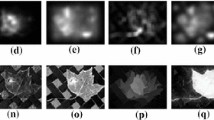Abstract
Focus-of-attention is extremely important in human visual perception. If computer vision systems are to perform tasks in a complex, dynamic world they will have to be able to control processing in a way that is analogous to visual attention in humans.
In this paper we will investigate problems in connection with foveation, that is in examining selected regions of the world at high resolution. We will consider a static world viewed by an active observer that has this capability. The tasks we will consider is that of finding and classifying junctions of contours, features that give important information about 3-dimensional structure like object shape and occlusions. Since they are completely local features, we can study them without treating the problem of integrating local information into global cues. We will show that foveation, as simulated by controlled, active zooming, allows robust detection and classification of junctions with very simple algorithms.
Access this chapter
Tax calculation will be finalised at checkout
Purchases are for personal use only
Preview
Unable to display preview. Download preview PDF.
Similar content being viewed by others
References
Ballard, D.H., (1987), Eye Movements and Visual Cognition, Proc. AAAI Workshop on Spatial Reasoning and Multi-Sensory Fusion, St Charles, III, 1987, 188–200
Bergholm, F., (1987), Edge Focusing, IEEE PAMI, 9: 6, 726–741
Brunnström, K., Eklundh, J.O., Kakimoto, A., (1989), On Focus of Attention and Active Computer Vision, Proc. NATO ASI on Robotics and Active Computer Vision, Springer Verlag, New York, in press
Burt, P.J., (1988), Attention Mechanisms for Vision in a Dynamic World, Proc. 9th I CPR, Rome, 1989, 977–987
Canny, J.F., (1986), A Computational Approach to Edge Detection, IEEE PAMI, 8: 6, 679–698
Harris, C., Stephens, M., (1988), A Combined Corner and Edge Detector, Proc. 4th Alvey Vision Conference, 1988, 147–152
Hückel, M., (1971), Operator which Locates Edges in Digitized Pictures, JACM, 18, 113–125
Kitchen, L., Rosenfeld, R., (1982), Gray-Level Corner Detection, Pattern Recognition Letters, 1: 2, 95–102
Marr, D., Hildreth, E., (1980), Theory of Edge Detection, Proc. Royal Society of London, B-207, 187–217
Moravec, H.P., (1977), Obstacle Avoidance and Navigation in the Real World by a Seeing Robot Rover, Stanford AIM-340
Lindeberg, T., Eklundh, J.O., (1989), On the Computation of a Scale-Space Primal Sketch, submitted
Malik, J., (1987), Interpreting Line Drawings of Curved Objects, Int. Journal of Computer Vision, 1: 1, 73–103
Nagel, H.H., (1986), Image Sequences - The (Octal) Years - From Phenomenology towards a Theoretical Foundation, Proc. 8th ICPR, 1174–1185
Nagel, H.H., (1989), Personal communication
Peleg, S., (1978), Iterative Histogram Modification 2, IEEE SMC, 8, 555–556
Waltz, D., (1975), Understanding Line Drawings of Scenes with Shadows, in Winstor, P.H., ed., The Psychology of Computer Vision, McGraw-Hill, New York
Waxman, A.M., Wu, J., Seibert, M., (1989), Computing Visual Motion in the Short and Long: From Receptive Fields to Neural Networks, Proc. IEEE Workshop on Visual Motion, Irvine, Ca., 1989, 156–164
Wilson, H.R., (1983), Psychophysical Evidence for Spatial Channels, Braddick, O.J., Sleigh, A.C., eds., in Physical and Biological Processing of Images, Springer Verlag, New York
Witkin, A.P., (1983), Scale-Space Filtering, Proc. 8th IJCAI, 1019–1021
Author information
Authors and Affiliations
Editor information
Editors and Affiliations
Rights and permissions
Copyright information
© 1992 Springer-Verlag Berlin Heidelberg
About this paper
Cite this paper
Brunnström, K., Eklundh, JO., Kakimoto, A. (1992). On Focus-of-Attention by Active Focusing. In: Sood, A.K., Wechsler, H. (eds) Active Perception and Robot Vision. NATO ASI Series, vol 83. Springer, Berlin, Heidelberg. https://doi.org/10.1007/978-3-642-77225-2_7
Download citation
DOI: https://doi.org/10.1007/978-3-642-77225-2_7
Publisher Name: Springer, Berlin, Heidelberg
Print ISBN: 978-3-642-77227-6
Online ISBN: 978-3-642-77225-2
eBook Packages: Springer Book Archive




